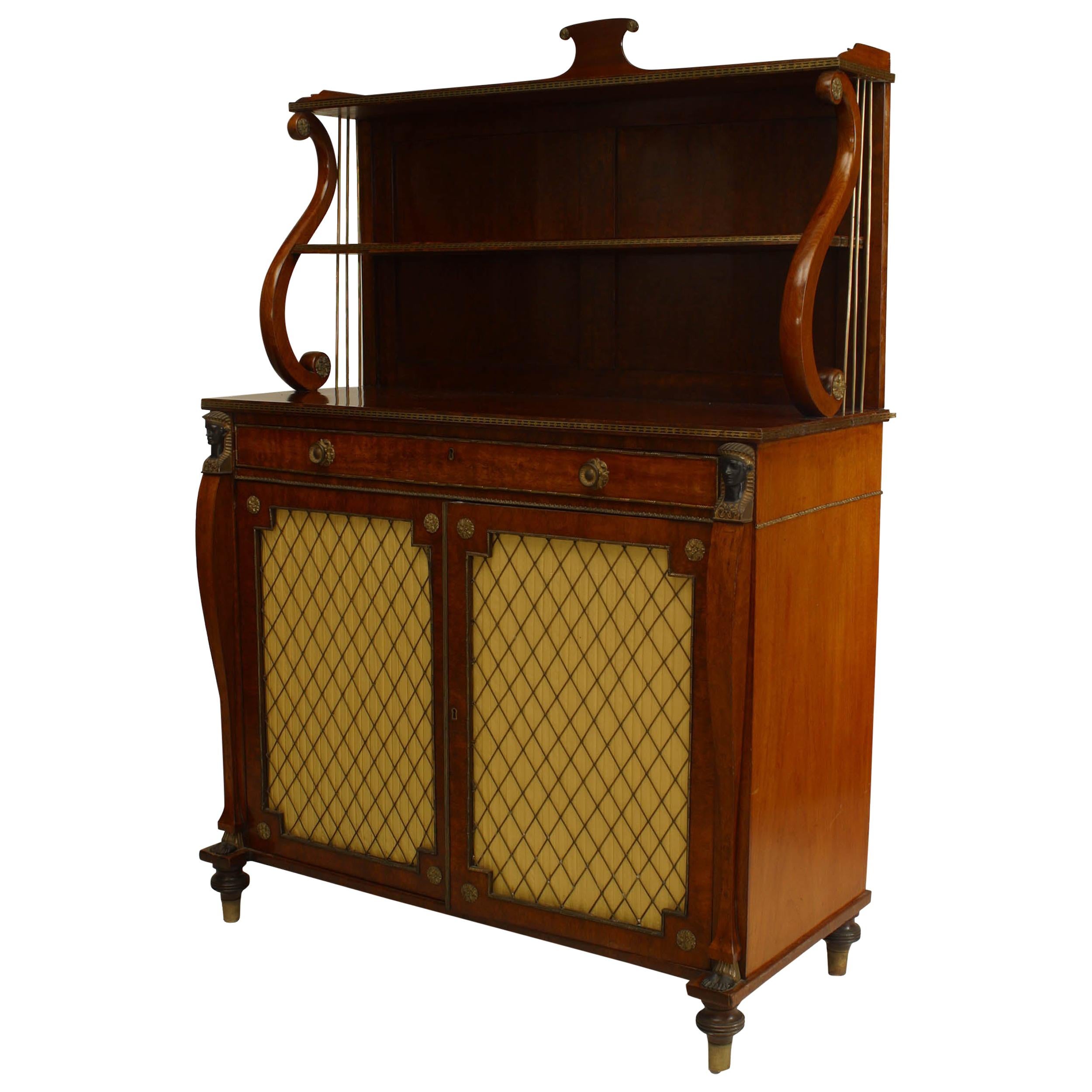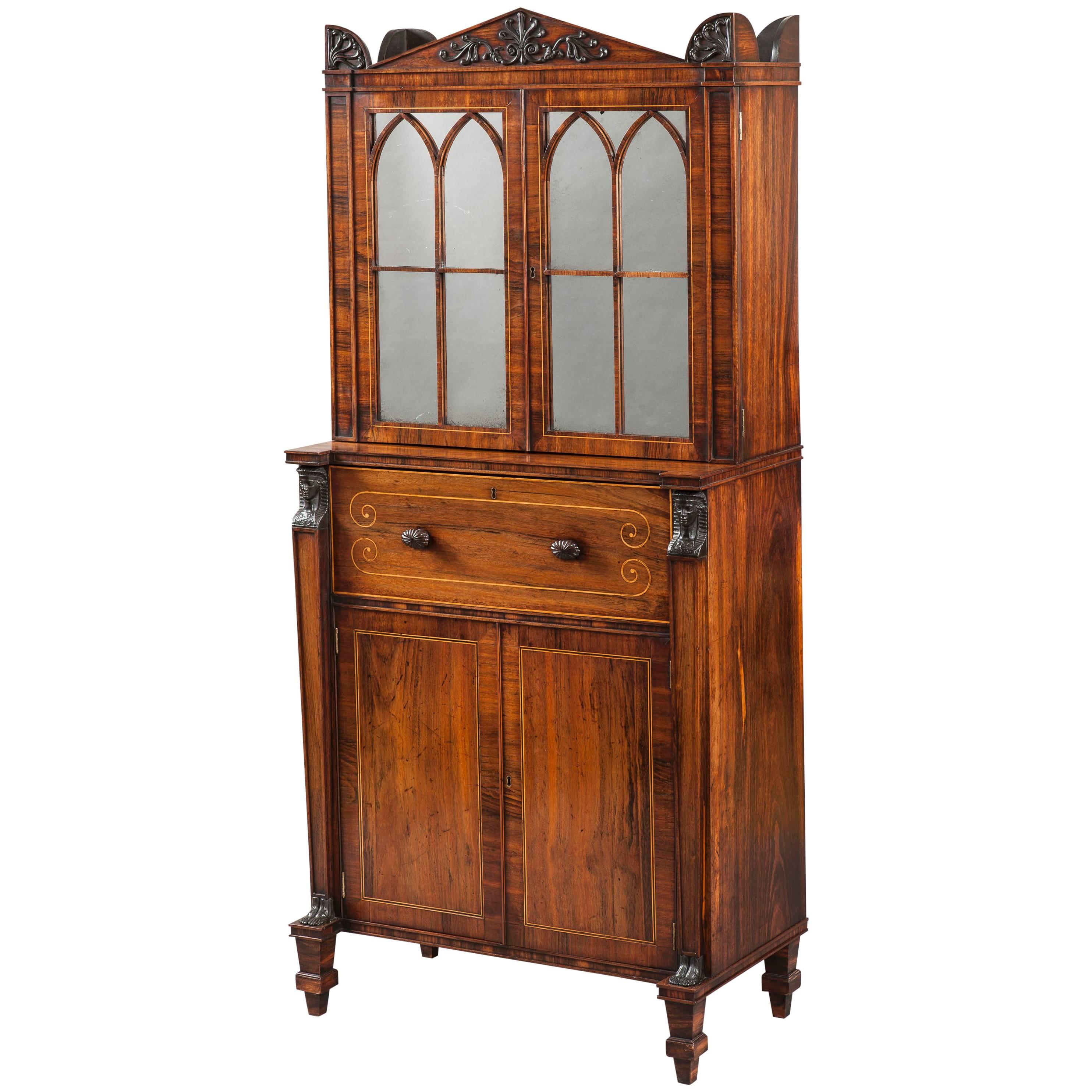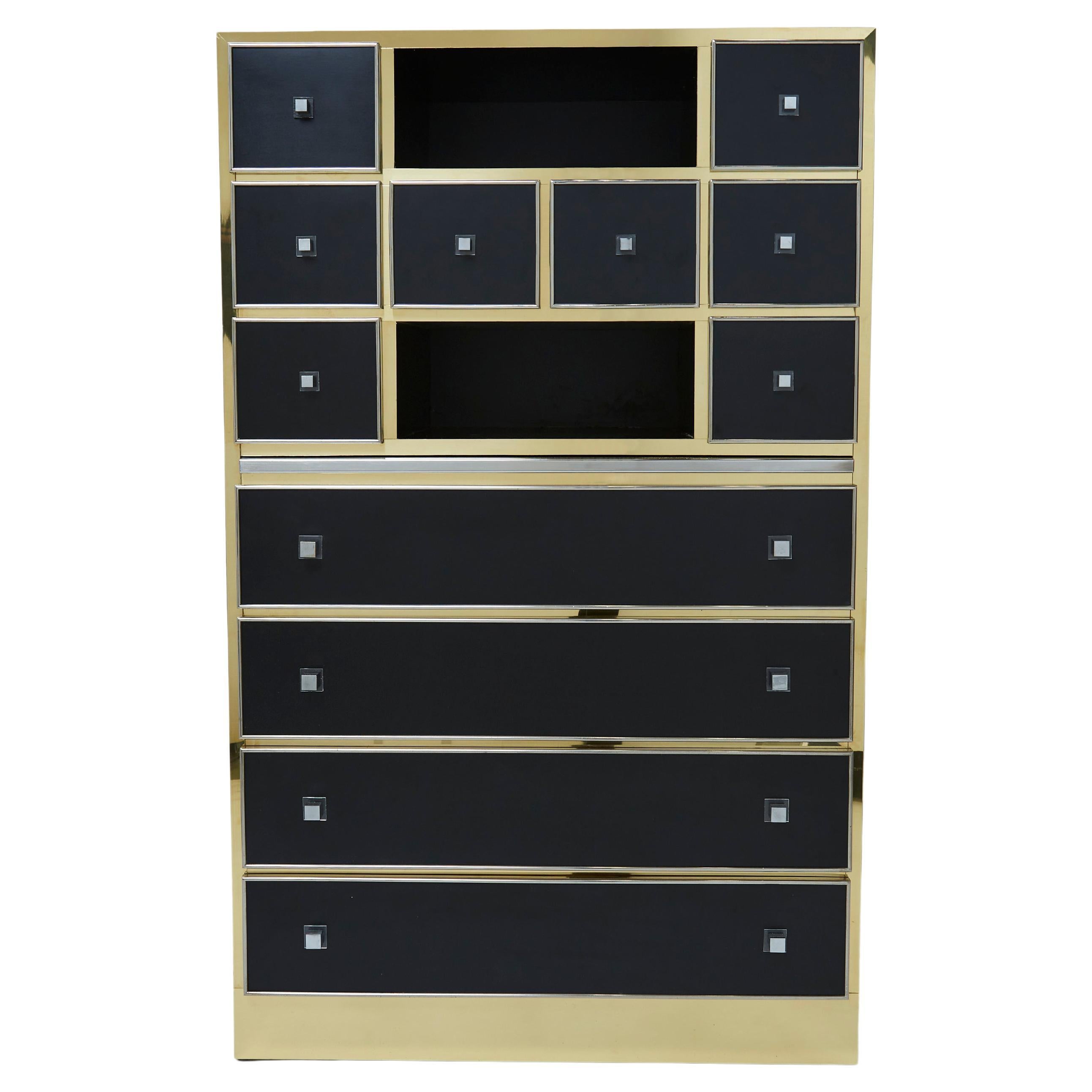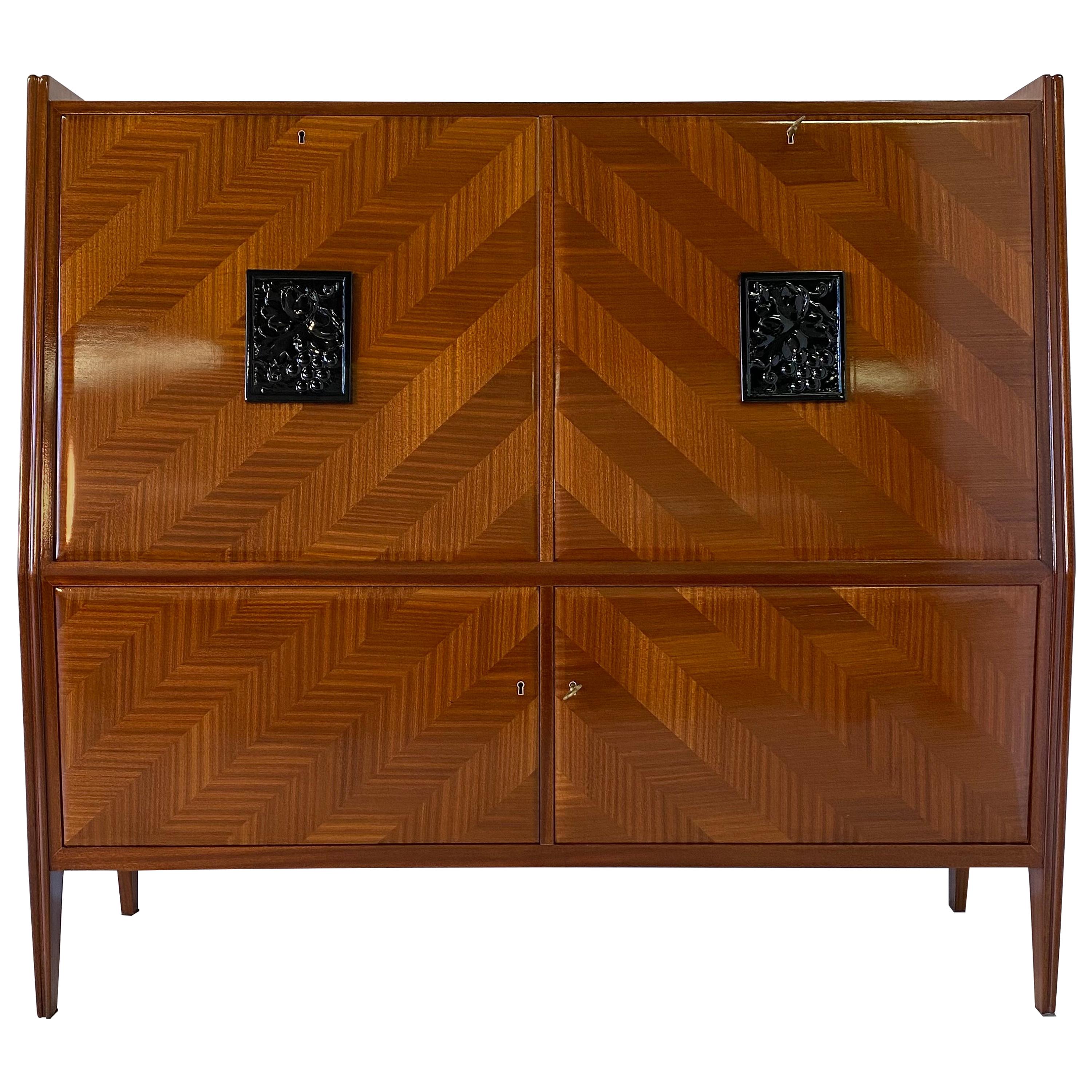Items Similar to Regency Brass-Inlaid Rosewood Secretaire Cabinet
Want more images or videos?
Request additional images or videos from the seller
1 of 10
Regency Brass-Inlaid Rosewood Secretaire Cabinet
About the Item
A Regency brass-inlaid rosewood secretaire cabinet, the rectangular top with a pierced galleried shelf with trellis work on the sides, above a secretaire drawer, banded with brass palm leaves on an ebony ground, enclosing nine satinwood shelves flanking four pigeon holes, with a red leather-inset fall front writing surface, the lower section comprising silk-lined trellis panelled doors, all on ormolu lions’ paw feet, decorated overall with classical palmettes and anthemion, the later locks stamped ‘Turners W. Hampton Patent’. English, circa 1810.
Provenance: The Marquess of Bristol and by descent to the late Frederick, 7th Marquess of Bristol, Ickworth, Suffolk, from whom bought privately by the present owner and kept at Ellerslie House.
Footnote: A pattern for this secretaire was entitled a ‘Lady’s Secretary’ and featured in Thomas Sheraton’s, ‘Cabinet Maker and Upholsterer’s Drawing Book’, 1791-3, Part III, pl XLIII. However various elements in the style and ornament of this piece relate to the work of John McLean & Son, Marylebone Street subscribers to Thomas Sheraton’s 1803 ‘Cabinet Dictionary’. For a related secretaire by McLean in the Victoria and Albert Museum see C Gilbert, ‘Pictorial Dictionary of Marked London Furniture 1700-1840.’ Leeds, 1996, fig. 596.
- Dimensions:Height: 49 in (124.46 cm)Width: 34.75 in (88.27 cm)Depth: 18 in (45.72 cm)
- Style:Regency (Of the Period)
- Materials and Techniques:
- Place of Origin:
- Period:
- Date of Manufacture:1810
- Condition:Wear consistent with age and use.
- Seller Location:Lymington, GB
- Reference Number:1stDibs: LU973023924872
About the Seller
5.0
Recognized Seller
These prestigious sellers are industry leaders and represent the highest echelon for item quality and design.
Established in 1982
1stDibs seller since 2013
Typical response time: 2 hours
Associations
LAPADA - The Association of Arts & Antiques Dealers
- ShippingRetrieving quote...Ships From: Lymington, United Kingdom
- Return PolicyA return for this item may be initiated within 14 days of delivery.
More From This SellerView All
- Pair of Regency Brass-Inlaid Rosewood Side CabinetsLocated in Lymington, HampshireA pair of Regency brass-inlaid rosewood side cabinets, each of rectangular form with a concave frieze concealing a button to open a pair of glazed with doors re-lined in yellow silk ...Category
Antique 19th Century British Regency Cabinets
MaterialsBrass
- Superb Regency Rosewood Side or Display CabinetLocated in Lymington, HampshireA superb Regency rosewood side or display cabinet, with the original rectangular white Carrera marble top above two long, glazed doors enclosing a mirrored interior with a single she...Category
Antique 1810s English Regency Cabinets
MaterialsMarble
- Pair of Late Regency Rosewood Side Cabinets, Attributed to GillowsBy Gillows of Lancaster & LondonLocated in Lymington, HampshireA pair of late Regency rosewood side cabinets, attributed to Gillows, each of rectangular form with two panelled doors below a single lon...Category
Antique 1820s English Regency Cabinets
MaterialsRosewood
- Regency Rosewood Two-Door Side Cabinet, Attributed to John McleanBy John McleanLocated in Lymington, HampshireA fine high Regency rosewood two-door side cabinet, attributed to John Mclean, of upright rectangular form, the upper section comprising two small drawers ...Category
Antique 1810s English Regency Cabinets
MaterialsRosewood
- Rosewood Regency Kneehole Bureau Cabinet Attributed to Seddon and MorelBy Morel & SeddonLocated in Lymington, HampshireAn impressive and monumental rosewood Regency kneehole bureau cabinet with ormolu mounts of exceptional quality, attributed to Seddon and Morel, the central roll-top opening to revea...Category
Antique 19th Century English Regency Cabinets
MaterialsOrmolu
- A fine late George III satinwood and snakewood secretaire cabinetBy George SimsonLocated in Lymington, HampshireA fine late George III satinwood and snakewood secretaire cabinet, attributed to George Simson of London, of rectangular form, the upper section with a pair of glazed doors with fine...Category
Antique Early 18th Century English George III Secretaires
MaterialsSatinwood
You May Also Like
- Regency Rosewood Secretaire Side Cabinet/ChiffoneerLocated in Folkestone, GBA superior quality and unusual Regency rosewood Side Cabinet, the top drawer with fold-down, leather-lined front, fully fitted with drawers and pigeon holes. below are a pair of silk...Category
Antique Early 19th Century English Regency Cabinets
MaterialsRosewood
- English Regency Rosewood SecretaireLocated in New York, NYEnglish Regency rosewood secretaire cabinet with two upper shelves supported by a lyre form over a secretaire drawer fitted with a leather wri...Category
Antique Mid-19th Century English Regency Secretaires
MaterialsRosewood
- English Regency Period Secrétaire Cabinet with Egyptian MotifsBy George OakleyLocated in London, GBA secrétaire cabinet of the Regency period Firmly attributed to George Oakley. Constructed in a finely faded and patinated goncalo alvez, having holly and purple heart stringing;...Category
Antique 19th Century English Regency Cabinets
MaterialsPurpleheart, Satinwood, Holly
- Michel Pigneres Brass Chrome Black Cabinet Secretaire, 1970sBy Michel PigneresLocated in Paris, IDFUnique French Mid-Century Modern cabinet secrétaire by Michel Pigneres made in the early 1970s. This piece is an exquisite example of refined, highly detailed and very well made furn...Category
Vintage 1970s French Mid-Century Modern Cabinets
MaterialsBrass, Chrome
- King George I Ambassadorial Secrétaire-CabinetLocated in New Orleans, LAThis highly important secrétaire-cabinet was crafted for and specially ordered by King George I for the British Ambassador to Russia. From its craftsmanship and materials to its exceptional artistry, it is a work of royal and historic significance that exudes power in each and every detail. The broken pediment at its apex features the simplified royal coat of arms bearing the king’s crown, while the interior is adorned by portraits of the British Royal Family. Placed within the ambassador’s St. Petersburg home, this entirely unique piece of furniture would have been a potent reminder of England's grandeur and political importance. Relations between England and Russia during this period were at an all-time high. Peter the Great had traveled to England in 1698 as part of his widely known “Grand Embassy” tour, wherein he attempted to gain foreign support against the Ottoman Empire. He spent a period of nearly four months there, meeting with King William III and his court on numerous occasions. Noted academic Arthur MacGregor wrote concerning the impact of the trip, “For two decades following Peter's visit, British influence in Russia reached a peak. It manifested itself in social custom, in craft practice and in ships and naval organization... it reached a significant sector of the population before relations cooled once again and the two nations pulled back from this era of unprecedented cordiality.” First and foremost, however, it is a reminder of British might and influence. By the reign of King George I, England had come into its own as a world power. Unique in its design, this cabinet is a reflection of the country’s might. It is crafted from the highest-quality solid walnut and burr walnut adorned by gilded lock plates and engraved hinges. The presence of ormolu at its apex and lining the doors was a rarity for this period, and its addition makes manifest the importance of the design. The outer doors open to reveal multiple interiors, including fifteen separate drawers around a central cupboard; the cupboard doors each bear mezzotint portraits of George I and his father, Ernest Augustus, Elector of Hanover. An etching after the portrait of George I dating to circa 1716 is in London’s Royal Academy. A second, inner pair of doors are adorned by mezzotints of the Prince and Princess of Wales (later Queen Caroline and George II), which are both after portraits by Sir Godfrey Kneller dated 1716 in the Royal Collection. A final portrait is revealed on the very interior of the cabinet, where a mezzotint of Frederick, Anne, Amelia and Caroline, children of the Prince of Wales, resides. An etching (circa 1715-1720) after this portrait can be found in the National Portrait Gallery (London). Apart from its abundance of royal portraiture, the cabinet features stunning painted decoration, including floral designs as well as clouds, birds and trees in a bucolic motif reminiscent of Eden. Its lower portion is a study in both form and function, featuring a fitted secrétaire-drawer above three additional drawers for storage. The cabinet appears in The Shorter Dictionary of English Furniture by R. Edwards from 1964, a text that is regarded as the bible of British furniture design. Edwards describes it as a “writing cabinet...given by George I to the British Ambassador at the Russian court.” The cabinet was likely made for the 18th-century German diplomat and writer Friedrich Christian Weber, who represented English interests at the Russian court from 1714 until 1719. Although Weber’s tenure as ambassador was relatively short, while in St. Petersburg, he authored his account entitled Das veraenderte Russland (The Present State of Russia), which was published in three volumes in 1721, 1739 and 1740. It may, however, also have been made for George Douglas, 2nd Earl of Dumbarton, who served as ambassador alongside Weber in 1716. Diplomatic relations ceased between the two countries in 1721. In 1928, the cabinet appeared for sale at the International Exhibition of Antiques & Works of Art in Olympia. It had previously been in the collection of the Woltner family of Bordeaux, the celebrated vintners who owned the estate Château Laville Haut-Brion and produced wine of the same name. According to the family, Monsieur Woltner was given the cabinet as a gift from an aunt who lived in Russia for many years. After leaving the Woltner collection, the cabinet was acquired by William Berry...Category
Antique 18th Century English Georgian Secretaires
MaterialsBrass
- Italian Mahogany Secretaire Cabinet, 1950sLocated in Meda, MBPrecious cabinet secretaire produced in Italy in the 1950s, The whole cabinet is veneered in mahogany with a fine solid wood carving in the center of the two doors representing two b...Category
Vintage 1950s Italian Mid-Century Modern Cabinets
MaterialsMahogany, Maple
Recently Viewed
View AllMore Ways To Browse
Bronze Or Brass Cabinets
London Used Furniture
Regency Brass
Cabinet Locks
Used Museum Cases
Brass Shelf With Cabinet
Antique Cabinet Locks
Inset Cabinets
Cabinets Stamped
Kitchen Rosewood
Inlaid Rosewood
Inlaid Side Cabinet
Antique Brass Shelf
Antique Rosewood Cabinet
Regency 1810
Regency Pattern
Leather Door Cabinet
3 Piece Cabinet





